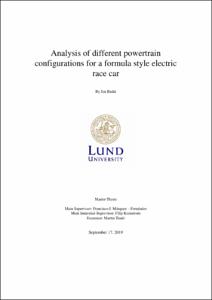Analysis of different powertrain configurations for a formula style electric racecar

Visualitza/Obre
Estadístiques de LA Referencia / Recolecta
Inclou dades d'ús des de 2022
Cita com:
hdl:2117/171833
Realitzat a/ambLunds universitet
Tipus de documentProjecte Final de Màster Oficial
Data2019-11-04
Condicions d'accésAccés obert
Tots els drets reservats. Aquesta obra està protegida pels drets de propietat intel·lectual i
industrial corresponents. Sense perjudici de les exempcions legals existents, queda prohibida la seva
reproducció, distribució, comunicació pública o transformació sense l'autorització del titular dels drets
Abstract
The aim of this thesis is to provide useful framework for the design of the upcoming electric race car of Lund Formula Student Team. The thesis intends to find the different powertrain concepts on the state of the art. From the configurations, the thesis should provide outcomes of the performance, efficiency, complexity design and cost. Furthermore, the best concept should be find and a simple preliminary design is made.To compare the different concepts developed, a Matlab code was used, which simulates the vehicle dynamics of the race cars. A Simulink model wasbe used to analyse the different electric systems and come up with the most efficient solution. The results of the thesis show that the powertrain configuration that should perform better in a real competition is the design with four motors actuating one in each wheel. The reason behind it, is the abilty of the system to provide different torque at each wheel, known as torque vectoring. By distributing different torque at each wheel the race car is able to create a yaw movement to the body, allowing it to make turns at a higher velocity. The design shows the different parts composing the powertrain, and how each of the parts was chosen. To conclude the thesis, the four motor’s configuration is compared to the LFS20 design in order to explain how this powertrain improves the car results in the overall competition
TitulacióMÀSTER UNIVERSITARI EN ENGINYERIA INDUSTRIAL (Pla 2014)
Col·leccions
| Fitxers | Descripció | Mida | Format | Visualitza |
|---|---|---|---|---|
| master-thesis.pdf | 5,566Mb | Visualitza/Obre |

